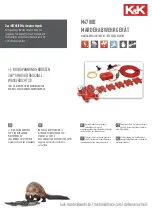
Unidrive M / Unidrive HS Modular Installation Guide
37
Issue Number: 5
4.1.1 DC fusing
The
Unidrive M/HS
modular system has undergone safety testing and proving when using the specified AC input fuses, including the case where the
size 11 twin rectifier is used to supply two D type modules. A fault in any module is cleared by the AC input fuses.
If more rectifiers or inverters are connected to the DC bus then the prospective fault current and the energy delivered before a fault is cleared are
increased because of the multiple sources and the increased stored energy in the inverter capacitors. It then becomes necessary to provide fuses in
the DC bus. This is illustrated in Figure 4-13.
Figure 4-13 Fault current contributions
As shown in Figure 4-14 when DC fuses are required they must be placed in the rectifier output circuits as well as the inverter inputs, since they are
also exposed to the total fault-current infeed. For the size 11 twin rectifier, only one fuse pair is needed for the complete module.
The only exception to this rule is where the rectifier input fuses are reduced in rating so that the total i2t let-through for all of the phases is no greater
than that for the standard recommended fuses for the 6-pulse arrangement. This will be the case for some of the lower-power multi-pulse
arrangements. This needs to be verified on a case-by-case basis.
All DC fuses are in pairs, i.e. one in each pole, to provide protection against earth faults.
Figure 4-14 12-pulse system using twin rectifiers and 6-phase AC distribution with odd number of inverter modules
DC fuse and cable ratings for Unidrive M / HS size 9, 10 and 11 inverters
on page 102 for DC fuse ratings.
(2)
(2)
(2)
A
C
fuses
not
a
de
q
u
at
e
DC
fuses
a
re re
q
u
i
red
A
C
fuses
a
re
a
de
q
u
at
e
(3)
(3)
(3)
(3)
(2)
(3)
(2)
(3)
NOTE
Summary of Contents for unidrive m
Page 157: ......
Page 158: ...0478 0141 05 ...
















































